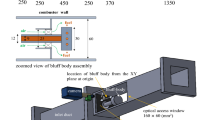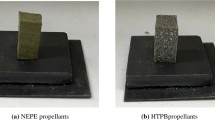Abstract
An axisymmetric viscous two-phase model is presented which describes the transient combustion of granular propellants during the ignition phase of a ballistic charge. Details of the model are presented along with computational results for a low-pressure ballistic simulator. Predicted pressure time evolutions are compared with experimental data of a real test-firing in which an unexpected pressure excursion occurred. Gun propellant breakup effects, due to bed compaction, are taken into consideration to explain the discrepancies between the numerical and experimental results. Finally, a discussion is presented of the mechanisms by which the behavior of pressure waves can be strongly influenced and thus controlled by the manner in which the propelling charge is ignited.
Similar content being viewed by others
References
Andersson KEB (1961) Pressure drop for ideal fluidization. Chem Eng Sciences 15
Baer MR, Gross RJ, Nunziato JW, Igel EA (1986) An experimental and theoretical study of deflagration-to-detonation transition (DDT) in the granular explosive, CP. Combustion and Flame 65:15
Baer MR, Nunziato JW (1986) A two-phase mixture theory for the deflagration-to-detonation (DDT) in reactive granular materials. Int J Multiphase Flow 12:861
Baer PG, Frankle JM (1962) The simulation of interior ballistics performance of guns by digital computer program. Ballistics Research Labs., Rept 1183
Benhaim P, Paulin JL, Zeller B (1978) Investigation on gun propellant breakup and its effects in interior ballistics. In: Proceedings of the 14h Int Symposium on Ballistics, Monterey, CA.
Bicen AF, Khezzar L, Whitelaw JH (1988) Subsonic single-phase flow in a gun simulator. AIAA J 25:47
Chen DY, Yang V, Kuo KK (1981) Boundary condition specification for mobile granular propellant bed combustion processes. AIAA J 19:1429
Ergun S (1952) Fluid flow through packed columns. Chem Eng Progress 48
Etablissements Techniques de Bourges (1986) Modélisation de l'Allumage en Configuration 105 OFL sur Simulateur d'Allumage, Etudes Diverses de Balistique Intérieure. PV 166, Essai 607 A, Etablissements Techniques de Bourges, Bourges
Fisher EB (1979) Investigation of breechblows phenomenology. Ballistics Research Labs., Final Rept DAAK11-78-C-0090, CALSPAN Corp.
Fisher ES, Trippe AP (1973) Development of a basis for acceptance of continuously produced propellant. CALSPAN Rept VQ-5163-D-1
Gelperin NI, Einstein VG (1971) Heat transfer in fliudized. In: Davidson JF, Harrison D (eds) Fluidization. Academic Press
Gibeling HJ, MacDonald H, Banks NE (1983) An implicit numerical analysis for two-dimensional, two-phase turbulent interior ballistic flows. AIAA Paper 83-0561
Gough PS, Zwarts FJ (1979) Modeling heterogeneous two-phase reacting flow. AIAA J 17:17
Gough PS (1980) The NOVA code: a user's manual. Vol. I. Description and use. IHCR 80-8, Naval Ordnance Station, Indian Head, MD
Gough PS (1990) The XNOVAKTC code. US Army Ballistic Research Laboratory Contractor Report, BRL-CR-627
Gütlin E, Heiser R, Hensel D, Zimmermann G (1987) Numerical and experimental investigation of the ignition process of a 105-mm tank gun round. In: Proceedings of the 10th Int symposium of ballistics, San Diego, CA.
Heiser R, Hensel D (1986) AMI: a general gasdynamic model of internal ballistics of guns. Fraunhofer-Institut für Kurzzeitdynamik (EMI), Weile am Rhein, Germany, Rept E 7/86
Heiser R, Hensel D (1988) Numerical optimization of the ignitor for large caliber weapons. In: Proceedings of the 4th Int gun propellant and propulsion symposium. Dover, NJ
Heiser R, Meineke E (1991) Multidimensional interior ballistic two-phase flow and the chambrage problem. Journal of Propulsion and Power 7:909
Heiser R, Garloff J (1992) Study on turbulence in interior ballistics flows. Journal of Propulsion and Power 8:59
Horst AW (1973) Navy gun interior ballistics modeling efforts: an overview. JANAF Propulsion Meeting, CPIA, Laurel, Md., Publ. 242
Horst AW, Minor TC (1978) Ignition-induced flow dynamics in bagged-charge artillery. In: Proceedings of the 4th international symposium on ballistics. Monterey, CA
Horst AW, May IW, Clarke EV Jr. (1978) The missing link between pressure waves and breechblows. Ballistics Research Labs., Rept BRL-MR 2849
Koo JH (1975) Theoretical modeling and numerical solution of transient combustion processes in mobil granular propellant beds. M.S. Thesis, Mech Eng Dept, University Park, PA
Krier H, Rajan S, Van Tassel WF (1976) Flame spreading and combustion in packed beds of propellant grains. AIAA J 14:301
Krier H, Gokhale SS (1976) Predictions of vigorous ignition dynamics for a packed bed of solid propellant grains. Int J of Heat and Mass Transfer 19:915
Krier H, Gokhale SS (1978) Modeling of convective mode combustion through granulated propellant to predict detonation transition. AIAA J 16:177
Kuo KK, Vichnevetsky R, Summerfield M (1973) Theory of flame front propagation in porous propellant charges under confinement. AIAA J 11:444
Kuo KK, Koo JH, Davis TR, Coates CR (1976) Transient combustion in mobile gas-permeable propellants. Acta Astronautica 3:573
Kuo KK (1986) Principles of combustion. John Wiley and Sons
MacCormack RW (1969) The effect of viscosity in hypervelocity impact cratering. AIAA Paper 69–354, Cincinnati, OH
May IW, Horst AW (1979) Interior ballistics of guns. In: Krier H, Summerfield M (ed) Progress in astronautics and aeronautics, Vol 66. AIAA, New-York, pp 197–227
Nuret JP, Reynaud JP (1992) Experimental characterization of ballistic consequences of mechanical solicitations on gun propellant grains. In: Proceedings of the 13th Int symposium on ballistics, Stockholm, Sweden.
Olenick PJ (1975) Investigation of the 76-mm/62 caliber Mark 75 Gun Mount Malfunction. Naval Surface Weapons Center, Dahlgren, Va., TR3144
Pfersmann (1987) Workshop on “Comparison between Multidimensional, Multiphase Models of Interior Ballistics.” Institut Franco-Allemand de Saint-Louis
Porterie B (1988) Modélisation de la Phase d'Allumage d'une Charge Propulsive en Balistique Intérieure. Thèse d'Etat, Marseille
Porterie B, Loraud JC, Larini M, Saurel R (1991) Gun propellant breakup effects on transient combustion processes. In: Takayama K (ed) Proceedings of the 18th Int symposium on shock waves, Sendai, Japan. Springer-Verlag
Porterie B, Loraud JC, Saurel R, Larini M (1992) A total non-equilibrium two-phase model for the ignition of ballistic charges. Proceedings of the 4th Int conference on fluid mechanics, Alexandrie.
Powers JM, Stewart DS, Krier H, Igel EA (1988) Progress in astronautics and aeronautics. AIAA New York 114:341
Powers JM, Stewart DS, Krier H (1990a) Theory of two-phase detonation. Part I: modeling. Combustion and Flame 80:264
Powers JM, Stewart DS, Krier H (1990b) Theory of two-phase detonation. Part II: structure. Combustion and Flame 80:280
Saurel R, Larini M, Loraud JC (1992a) Ignition and growth of a detonation by a high energy plasma. Shock Waves 2:19
Saurel R, Larini M, Loraud JC (1992b) Numerical modelling of deflagration detonation transition produced by laser impact on granular explosive. Computational Fluid Dynamics J 1:155
Spalding DB (1981) Numerical computation of two-phase flow in gun barrels. Presented at the US Army Workshop on Multiphase Flow, Ballistics Research Labs.
Steffens (1987) Workshop on “Comparison between Multidimensional, Multiphase models of Interior Ballistics.” Institut Franco-Allemand de Saint-Louis
Sugot G (1928) Balistique Intérieure Théorique et Tables Numériques. Gauthier-Villars, Paris
Van Tassel WF, Krier H (1975) Combustion and flame spreading phenomena in gas-permeable explosive materials. Int J of Heat and Mass Transfer 18:1377
Warming RF, Beam RM (1976) Upwind second-order difference schemes and applications in aerodynamic flows. AIAA J 4
Weinmann C (1980) Etude de la sensibilité des poudres propulsives au phénomène de rupture fragile. In: Proceedings of the 5th Int symposium on ballistics, Toulouse, France.
Yanhuang Z, Jianguo W, Ming S (1992) Examination of a breechblow catastrophe in a 122-mm cannon gun with whole charge. In: Proceedings of the 13th Int symposium on ballistics, Stockholm, Sweden.
Author information
Authors and Affiliations
Additional information
This article was processed using Springer-Verlag TEX Shock Waves macro package 1.0 and the AMS fonts, developed by the American Mathematical Society.
Rights and permissions
About this article
Cite this article
Porterie, B., Loraud, J.C. An investigation of interior ballistics ignition phase. Shock Waves 4, 81–93 (1994). https://doi.org/10.1007/BF01418571
Received:
Accepted:
Issue Date:
DOI: https://doi.org/10.1007/BF01418571




